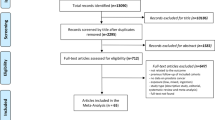Abstract
Objective
PET cancer screening is performed widely in Japan as opportunistic screening, but no study has focused on the correlation with various cancer risk factors and the seeking bias of examinees and cancer detection rate. Analyzing our large series of PET cancer screening data, correlations with cancer detection rates according to general cancer risk factors and PET detection survey were reviewed, and the selection bias of the medical examinees was determined.
Methods
19189 examinees who underwent PET cancer screening were enrolled. Using logistic-regression analysis, we analyzed correlations between smoking history/drinking history/cancer family history and detection rates of thyroid cancer/breast cancer/colorectal cancer/lung cancer, which are the main malignancies detected in PET cancer screening. In addition, we evaluated seeking bias of examinees, analyzing correlations between the presence of cancer risk factors and prior screening checkups at other institutions to our PET cancer screening using a matched case–control study.
Results
Cancer detection rates by FDG-PET were 1.17% (224/19189), being much higher than those of standard cancer mass screenings. In males, statistically significant correlations were seen between lung cancer and smoking, and between prostate cancer and a family history of prostate cancer, but not between the detection rates of three other types of cancer (thyroid cancer/lung cancer/colorectal cancer) and other cancer risk factors. In females, detection rates of four types of cancer (thyroid cancer/lung cancer/colorectal cancer/breast cancer) were significantly higher in the examinees without cancer risks, and subgroup analysis according to types of cancer did not indicate significant correlations either. The matched case–control study evaluating seeking bias indicated that a significant proportion of the examinees with cancer risks had undergone prior cancer screening at other institutions.
Conclusions
Our study indicated that there was significant seeking bias for prior screening of examinees, with this accounting for the fact that this study did not find a significant correlation between cancer risks and cancer detection rates. The results of our study indicated that PET cancer screening can provide high cancer detection rates.

Similar content being viewed by others
References
Uno K, Jinnouchi S. Practice guidelines for PDG-PET cancer screening. Kaku Igaku. 2007;44:1–28.
Yasuda S, Shohtsu A. Cancer screening with whole-body 18F-fluorodeoxyglucose positron-emission tomography. Lancet. 1997;350:1819.
Yasuda S, Ide M, Fujii H, Nakahara T, Mochizuki Y, Takahashi W, et al. Application of positron emission tomography imaging to cancer screening. Br J Cancer. 2000;83:1607–11.
List of PET faculty (7 October 2009). Japanese Council of PET Imaging, 2009. http://www.jcpet.jp/1-3-4-1. Accessed 23 Nov 2009.
Kojima S, Zhou B, Teramukai S, Hara A, Kosaka N, Matsuo Y, et al. Cancer screening of healthy volunteers using whole-body 18F-FDG-PET scans: The Nishidai clinic study. Eur J Cancer. 2007;43:1842–8.
Minamimoto R, Senda M, Uno K, Jinnouchi S, Iinuma T, Ito K, et al. Performance profile of FDG-PET and PET/CT for cancer screening on the basis of a Japanese Nationwide Survey. Ann Nucl Med. 2007;21:481–98.
Kakizoe T. Gantaisakukihonnho To Nyugankenshin (fundamental law for anti-cancer measures and breast cancer screening). J Jpn Assoc Breast Cancer Screen. 2007;16:142–8 (in Japanese).
Weckesser M, Schober O. Is whole-body FDG-PET valuable for health screening? Against. Eur J Nucl Med Mol Imaging. 2005;32:342–3.
Silverman DHS. Comments and perspectives. Screening 18F-FDG whole-body scanning: AWESOM-PET or FALSPOS-PET? J Nucl Med. 2005;46:717.
Ide M, Suzuki Y. Is whole-body FDG-PET valuable for health screening? For. Eur J Nucl Med Mol Imaging. 2005;32:339–41.
Katou K, Sakuta M. Smokefree policy of each 47 prefecture in 2007. Jpn J Tob Control. 2007;2.
New Surgeon General’s report expands list of smoking-related diseases. FDA Consum. 2004;38:9.
Eberl MM, Sunga AY, Farrell CD, Mahoney MC. Patients with a family history of cancer: identification and management. J Am Board Fam Pract. 2005;18:211–7.
Blot WJ. Alcohol and cancer. Cancer Res (Suppl). 1992;52:2119s–23s.
Stinson FS, DeBakey SF. Alcohol-related mortality in the United States, 1979–1988. Br J Addict. 1992;87:777–83.
Schoder H, Gonen M. Screening for cancer with PET and PET/CT: potential and limitations. J Nucl Med. 2007;48:4S–18S.
Terauchi T, Murano T, Daisaki H, Kanou D, Shoda H, Kakinuma R, et al. Evaluation of whole-body cancer screening using 18F-2-deoxy-2-fluoro-d-glucose positron emission tomography: a preliminary report. Ann Nucl Med. 2008;22:379–85.
Ono K, Ochiai R, Yoshida T, Kitagawa M, Omagari J, Kobayashi H, et al. The detection rates and tumor clinical/pathological stages of whole-body FDG-PET cancer screening. Ann Nucl Med. 2007;21:65–72.
Rohren EM, Turkington TG, Coleman RE. Clinical applications of PET in oncology. Radiology. 2004;231:305–32.
Berghmans T, Dusart M, Paesmans M, Hossein-Foucher C, Buvat I, Castaigne C, et al. Primary tumor standardized uptake value (SUVmax) measured on fluorodeoxyglucose positron emission tomography (FDG-PET) is of prognostic value for survival in non-small cell lung cancer (NSCLC): a systematic review and meta-analysis (MA) by the European Lung Cancer Working Party for the IASLC Lung Cancer Staging Project. J Thorac Oncol. 2008;3:6–12.
Yasuda S, Ide M. PET and cancer screening. Ann Nucl Med. 2005;19:167–77.
Jinnouchi M, Nakajo M, Tateno R, Tanabe H. Analysis of colon cancer detected in cancer screening with FDG-PET: comparing with feces occult blood test and CEA. Nihon Gan-Kenshinn Shindan Gakkaishi. 2007;14:150–5. (in Japanese).
Beinfeld MT, Wittenberg E, Gazelle GS. Cost-effectiveness of whole-body CT screening. Radiology. 2005;234:415–22.
Brenner D, Elliston C, Hall E, Berdon W. Estimated risks of radiation-induced fatal cancer from pediatric CT. AJR Am J Roentgenol. 2001;176:289–96.
Pastorino U, Bellomi M, Landoni C, De Fiori E, Arnaldi P, Picchio M, et al. Early lung-cancer detection with spiral CT and positron emission tomography in heavy smokers: 2-year results. Lancet. 2003;362:593–7.
Acknowledgments
This study was supported by a Grant-in-Aid for the Third-term Comprehensive 10-year Strategy for Cancer Control, a Grant-in-Aid for Cancer Research from the Ministry of Health, Labour and Welfare, Japan.
Author information
Authors and Affiliations
Corresponding author
Rights and permissions
About this article
Cite this article
Shibata, K., Arai, M., Matsuura, M. et al. Relationship of detection rate of PET cancer screening examinees and risk factors: analysis of background of examinees. Ann Nucl Med 25, 261–267 (2011). https://doi.org/10.1007/s12149-010-0458-7
Received:
Accepted:
Published:
Issue Date:
DOI: https://doi.org/10.1007/s12149-010-0458-7




